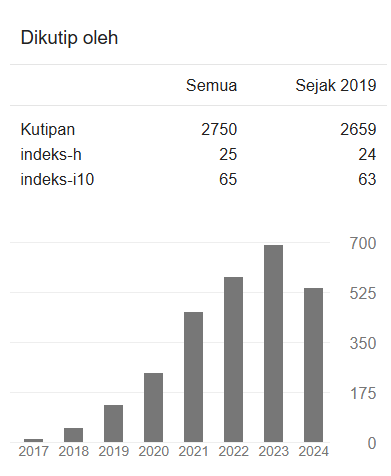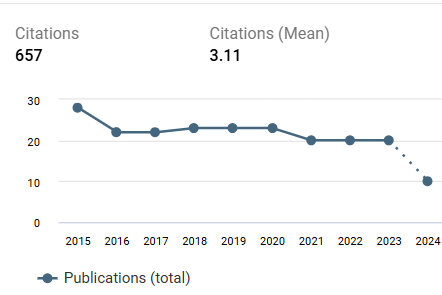PEMBELAJARAN KLASIFIKASI KLADOGRAM DENGAN METODE TAKSIMETRI UNTUK MEMPELAJARI KEKERABATAN TANAMAN GENUS TILLANDSIA & NEOREGELIA
DOI:
https://doi.org/10.22219/jinop.v6i1.7084Keywords:
Cladogram, Kinship Tillandsia & Neoregelia, Taximetry, Classification LearningAbstract
ABSTRAK
Lingkungan SMAN 3 Malang memiliki konsep taman vertikal, sehingga cocok digunakan tempat pembelajaran outdoor learning dan pembelajaran langsung. Hasil observasi menunjukkan pemanfaatan tanaman untuk media pembelajaran belum optimal. Belum optimalnya disebabkan belum adanya informasi nama ilmiah, deskripsi, dan hubungan kekerabatan tumbuhan. Berdasarkan hal tersebut maka perlu dilakukan inovasi pembelajaran. Penelitian ini bertujuan mendeskripsikan penerapan pembelajaran klasifikasi kladogram dengan metode taksimetri: 1) pemanfaatan tanaman tillandsia & neoregelia untuk sumber belajar klasifikasi & kladogram tanaman, 2) jumlah spesies tillandsia & neoregelia, 3) hubungan kekerabatan tanaman tillandsia & neoregelia. Penelitian ini merupakan deskriptif dengan metode survey, melalui pembelajaran klasifikasi & kladogram dengan taksimetri. Teknik analisis data secara deskriptif yaitu identifikasi jenis-jenis tumbuhan menggunakan gambar dan buku kunci determinasi (taksimetri). Hasil menunjukkan bahwa melalui pembelajaran klasifikasi kladogram dengan metode taksimetri diperoleh data sebagai berikut 1) pemanfaatan tanaman dengan ciri morfologi serta persamaan dan perbedaannya menjadi sumber belajar klasifikasi tumbuhan & pembuatan kladogram berlangsung dengan efektif dimana ditunjukkan dengan siswa terampil dalam melakukan klasifikasi tanaman yang ada di lingkungan sekolah dan terampil membuat kladogram dari kegiatan klasifikasi, 2) terdapat 2 spesies tillandsia yaitu Tillandsia lonantha & Tillandsia cyanea serta terdapat 1 spesies neoregelia yaitu Neoregelia spectabilis, 3) hubungan kekerabatannya tanaman tersebut satu family yaitu Bromeliaceae.
Kata Kunci: Kekerabatan Tillandsia & Neoregelia; Kladogram; Taksimetri; Pembelajaran Klasifikasi
ABSTRACT
The environment of State Senior High School (SMAN) 3 Malang employed a concept of vertical garden, making the environment suitable for outdoor learning and direct learning. Observation results indicated the use of plants for learning media is not optimal due to the lack of information on scientific names, descriptions, and relationships of plants. Based on the observation, it was necessary to design a learning innovation. This research aimed to describe the application of Cladogram classification learning with the Asymmetric method: 1) the utilization of Tillandsia & Neoregelia plants for the source of plant classification & Cladogram learning, 2) the number of Tillandsia & Neoregelia species, 3) the relationship between Tillandsia & Neoregelia plants. This research employed a descriptive survey method through learning classification & Cladograms with Asymmetry. The descriptive data analysis technique defined the identification of plant types using pictures and key books of determination (asymmetry). The results showed that through the learning of cladogram classification with the asymmetry method, the following data were obtained: 1) the use of plants with morphological characteristics and similarities and differences became the source of learning for plant classification and making cladograms effectively indicated by students performance in doing the classification of plants in the school environment and making cladograms from classification activities, 2) there were two species of tillandsia namely Tillandsia lonantha & Tillandsia cyanea, and there were one neoregelia species namely Neoregelia spectabilis, 3) familial relationship of the plant is one family namely Bromeliaceae.
Keywords: Cladogram; Kinship Tillandsia & Neoregelia; Taximetry; Classification Learning
Downloads
References
Arends, R. I. (2008). Learning to Teach. Yogyakarta: Pustaka Pelajar.
Arrijani. (2003). Kekerabatan fenetik anggota marga Knema, Horsfieldia, dan Myristicadi Jawa berdasarkan bukti morfologi serbuk Sari. Biodiversitas, 4(2), 83–88. doi: https://doi.org/10.13057/biodiv/d040203
Astirin, O. P. (2000). Permasalahan pengelolaan keanekaragaman hayati di Indonesia. Biodiversitas, 1(1), 36–40. doi: https://doi.org/10.13057/biodiv/d010107
Chase, M. W. (2005). Classification of orchidaceae in the age of dna data. Curtis’s Botanical Magazine. doi: https://doi.org/10.1111/j.1355-4905.2005.00466.x
Dubois, A. (2007). Naming taxa from cladograms: a cautionary tale. Molecular Phylogenetics and Evolution, 42(2), 317–330. doi: https://doi.org/10.1016/j.ympev.2006.06.007
Irawan, B., Muadz, S., & Rosadi, A. (2013). Karakterisasi dan kekerabatan tumbuhan mangrove Rhizophoraceae berdasarkan morfologi, anatomi dan struktur luar serbuk sari. Prosiding Seminar Nasional Sains Dan Teknologi Nuklir PTNBR-BATAN Bandung. Retrieved from http://digilib.batan.go.id/ppin/katalog/file/1858-3601-2013-289-297.pdf
Mayr, E., & Bock, W. J. (2008). Classifications and other ordering systems. Journal of Zoological Systematics and Evolutionary Research, 40(4). doi: https://doi.org/10.1046/j.1439-0469.2002.00211.x
McCarthy, I., Ridgway, K., Leseure, M., & Fieller, N. (2000). Organisational diversity, evolution and cladistic classifications. Omega, 28(1), 77–95. doi: https://doi.org/10.1016/S0305-0483(99)00030-4
Ramadhani, W. S., Erman, & Indah, N. K. (2016). Penerapan pembelajaran outdoor learning process (OLP) melalui pemanfaatan taman sekolah sebagai sumber belajar materi klasifikasi tumbuhan untuk meningkatkan hasil belajar siswa SMP. Jurnal Pendidikan Sains, 4(3). Retrieved from http://jurnalmahasiswa.unesa.ac.id/index.php/pensa/article/view/ 15312/13870
Schneider, K. L., Marrero, G., Alvarez, A. M., & Presting, G. G. (2011). Classification of plant associated bacteria using rif, a computationally derived dna marker. PloS One, 6(4). doi: https://doi.org/10.1371/journal.pone.0018496
Setiawan, A. B., Wisanti., & Faizah, U. (2014). Pengembangan lembar kegiatan siswa klasifikasi tumbuhan dengan memanfaatkan spesimen awetan untuk melatihkan keterampilan proses peserta didik kelas x. Jurnal BioEdu (Berkala Ilmiah Pendidikan Biologi), 3(3). Retrieved from http://ejournal.unesa.ac.id/index.php/bioedu
Sihvonen, P., & Kaila, L. (2004). Phylogeny and tribal classification of Sterrhinae with emphasis on delimiting Scopulini (Lepidoptera: Geometridae). Systematic Entomology, 29(3). doi: https://doi.org/10.1111/j.0307-6970.2004.00248.x
Skevington, J. H., & Yeates, D. K. (2001). Phylogenetic classification of eudorylini (diptera: pipunculidae). Systematic Entomology, 26(4). doi: https://doi.org/10.1046/j.0307-6970.2001.00160.x
Sudjana, N., & Rivai, A. (2011). Media Pengajaran. Jakarta: PT. Sinar Baru Algensindo.
Suprijono, A. (2009). Cooperative Learning: Teori dan Aplikasi PAIKEM. Yogyakarta: Pustaka Pelajar.
Susilo, M. J. (2015). Identifikasi tumbuhan berbiji (Spermatophyta) sebagai materi pembelajaran IPA-Biologi SMP berbasis potensi lokal di kawasan pasir pantai Depok kabupaten Bantul. Prosiding Seminar Nasional Pendidikan Biologi 2015, Yang Diselenggarakan Oleh Prodi Pendidikan Biologi FKIP Universitas Muhammadiyah Malang, Tema:”Peran Biologi Dan Pendidikan Biologi Dalam Menyiapkan Generasi Unggul Dan Berdaya Saing Global. Retrieved from http://research-report.umm.ac.id/index.php/research-report/article/view/489/713
Tellu, A. T. (2005). Kunci identifikasi rotan (Calamus spp.) asal Sulawesi Tengah berdasarkan struktur anatomi batang. Jurnal BIODIVERSITAS, 6(2), 113–117. doi: https://doi.org/10.13057/biodiv/d060209, ISSN: 1412-033XDownloads
Published
How to Cite
Issue
Section
License
Copyright Notice
Authors who publish with JINoP (Jurnal Inoasi Pembelajaran) agree to the following terms:
- For all articles published in the JINoP (Jurnal Inovasi Pembelajaran), copyright is retained by the authors. Authors give permission to the publisher to announce the work with conditions. When the manuscript is accepted for publication, the authors agree to the automatic transfer of the publishing right to the publisher.
- Authors retain copyright and grant the journal the right of first publication with the work simultaneously licensed under a Creative Commons Attribution 4.0 International License. that allows others to share the work with an acknowledgment of the work's authorship and initial publication in this journal.
- Authors are able to enter into separate, additional contractual arrangements for the non-exclusive distribution of the journal's published version of the work (e.g., post it to an institutional repository or publish it in a book), with an acknowledgment of its initial publication in this journal.
- Authors are permitted and encouraged to post their work online (e.g., in institutional repositories or on their website) prior to and during the submission process, as it can lead to productive exchanges, as well as earlier and greater citation of published work (See The Effect of Open Access).








